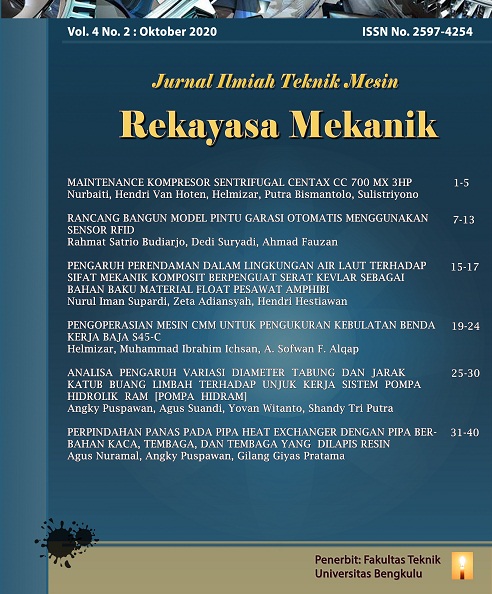Main Article Content
Abstract
In this study, a heat exchanger will be designed with the principle of tube-pond, normal water flowing tubes and hot water-filled ponds. This study aims to determine the heat transfer characteristics of glass pipe, copper, and resin coated copper.The materials used in the tube were glass, copper, and resin coated copper, polyester resin of yukalac BTQN 157 and a catalyst of methyl ethyl ketone peroxide. In the test, the water temperature variation in ponds was 70?C, 80?C, and 90?C. At each temperature, the test was carried out by flowing normal water into the tube by varying the discharge by 1lpm, 0.8lpm, 0.6lpm, 0.4lpm, and 0.2lpm. The values for the temperature in and out of the water in the tube are obtained. So that the overall heat transfer coefficient value and its effectiveness can be calculated.The results showed that the higher the discharge, the overall heat transfer coefficient on the tube increased. where the highest value is in the copper tube meterial at 1 lpm discharge, which is at 80?C pond temperature of 1544.163 W / m2?C. While the smallest value of the overall heat transfer coefficient is the glass
material at the time of discharge 0.2 lpm, which is at a temperature of 90?C of 199.5889 W / m2?C
Keywords
Article Details
References
- Risano, A.Y.E., Su’di, A and Rendy, D.A.P.
- “Perancangan Heat Exchanger Pada
- Binary Power Plant Kapasitas 100 KW Yang
- Memanfaatkan Uap Sisa PLTP Ulu Belu.”
- (September).
- Scheiber, J., Ravier, G., Cuenot, N., Genter, A.
- “In-Situ Material and Corrosion Studies
- at the Soultz-Sous-Forêts ( France ) EGS Site.”
- (April): 19–25.
- Gunnlaugsson, E., Armannsson, H.,
- Thorhallsson, S., Steingrimsson, B. 2014.
- “Problems In Geothermal Operation.” : 1–18.
- Norton, J.F., Maier, M.,Bakker, W.T. 2010.
- “Corrosion of heat exchanger alloys exposed to
- a non-equilibrated CO-based sulfidizing
- environment at 550?C”. 433: 424–33.
- Emmons, E., Shamberger, P.J. 2018. “Corrosive
- Effect of Lithium Nitrate Trihydrate on
- Common Heat Exchanger
- Materials.”(September).
- Liu, C., Little, J.A. Henderson, P. J., Ljung, P.
- “Corrosion of HR3C heat exchanger alloy
- in a biomass fired PF utility boiler.” Materials
- and Corrosion 51: 765-773.
- Bar-Cohen, A., Rodgers, P., Cevallos,J.G. 2008.
- “Application Of Thermally Enhanced
- Thermoplastics to Seawater-Cooled LiquidLiquid
- Heat Exchangers.” University of
- Maryland, College Part, MD, United States of
- America.
- Yan, J.,Zhou, T.,Masuda, J.,Kuriyagawa, T.
- “Modeling high-temperature glass
- molding process by coupling heat transfer and
- viscous deformation analysis.”Departement of
- Nanomechanics, Graduete School of
- Engineering, Tohaku university, Japan.
- Irvan O. 2016. “Analisa peleburan limbah
- plastik jenis polyethylene terphtalate (pet)
- menjadi biji plastik melaluipengujian alat
- pelebur plastik.” Program Studi Teknik Mesin,
- Fakultas Teknik, Universitas Mercu Buana,
- Jakarta.
- Meilani, H.,Wuryandani, D. 2010.“Potensi
- Panas Bumi Sebagai Energi Alternatif
- Pengganti Bahan Bakar Fosil untuk Pembangkit
- Tenaga Listrik Di Indonesia.”
- Bizzy I., Setiadi, R. 2013. “Studi Perhitungan
- Alat Penukar Kalor Tipe Shell and Tube
- Dengan Program Heat Transfer Research Inc
- (HTRI).”Jurusan Teknik Mesin, Fakultas
- Teknik, Universitas Sriwijaya.
- Holman, J.P. 1991, Perpindahan Kalor, Ed.6,
- Jakarta: Erlangga.
References
Risano, A.Y.E., Su’di, A and Rendy, D.A.P.
“Perancangan Heat Exchanger Pada
Binary Power Plant Kapasitas 100 KW Yang
Memanfaatkan Uap Sisa PLTP Ulu Belu.”
(September).
Scheiber, J., Ravier, G., Cuenot, N., Genter, A.
“In-Situ Material and Corrosion Studies
at the Soultz-Sous-Forêts ( France ) EGS Site.”
(April): 19–25.
Gunnlaugsson, E., Armannsson, H.,
Thorhallsson, S., Steingrimsson, B. 2014.
“Problems In Geothermal Operation.” : 1–18.
Norton, J.F., Maier, M.,Bakker, W.T. 2010.
“Corrosion of heat exchanger alloys exposed to
a non-equilibrated CO-based sulfidizing
environment at 550?C”. 433: 424–33.
Emmons, E., Shamberger, P.J. 2018. “Corrosive
Effect of Lithium Nitrate Trihydrate on
Common Heat Exchanger
Materials.”(September).
Liu, C., Little, J.A. Henderson, P. J., Ljung, P.
“Corrosion of HR3C heat exchanger alloy
in a biomass fired PF utility boiler.” Materials
and Corrosion 51: 765-773.
Bar-Cohen, A., Rodgers, P., Cevallos,J.G. 2008.
“Application Of Thermally Enhanced
Thermoplastics to Seawater-Cooled LiquidLiquid
Heat Exchangers.” University of
Maryland, College Part, MD, United States of
America.
Yan, J.,Zhou, T.,Masuda, J.,Kuriyagawa, T.
“Modeling high-temperature glass
molding process by coupling heat transfer and
viscous deformation analysis.”Departement of
Nanomechanics, Graduete School of
Engineering, Tohaku university, Japan.
Irvan O. 2016. “Analisa peleburan limbah
plastik jenis polyethylene terphtalate (pet)
menjadi biji plastik melaluipengujian alat
pelebur plastik.” Program Studi Teknik Mesin,
Fakultas Teknik, Universitas Mercu Buana,
Jakarta.
Meilani, H.,Wuryandani, D. 2010.“Potensi
Panas Bumi Sebagai Energi Alternatif
Pengganti Bahan Bakar Fosil untuk Pembangkit
Tenaga Listrik Di Indonesia.”
Bizzy I., Setiadi, R. 2013. “Studi Perhitungan
Alat Penukar Kalor Tipe Shell and Tube
Dengan Program Heat Transfer Research Inc
(HTRI).”Jurusan Teknik Mesin, Fakultas
Teknik, Universitas Sriwijaya.
Holman, J.P. 1991, Perpindahan Kalor, Ed.6,
Jakarta: Erlangga.

